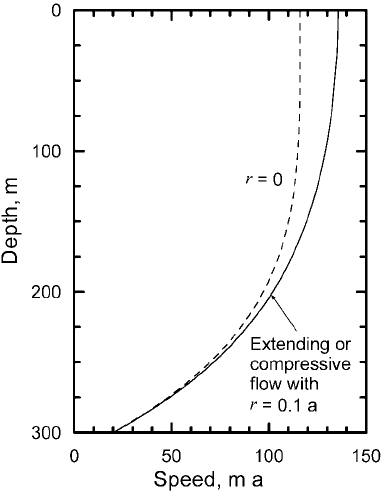Hooke R.L. Principles of glacier mechanics
Подождите немного. Документ загружается.


Solutions for stresses and velocities 281
not necessarily valid at the ends of the slab. Note also that between
any two vertical sections, x
1
and x
1
+ x, u increases by b
n
x/h,which
would be the increase in mean velocity required to transmit the additional
flux, b
n
x,downglacier – the balance velocity that we discussed in
Chapter 5.
If there is no accumulation or ablation, b
n
= 0, and thus u = c and
w = 0 throughout the block. In this case there is no internal deformation.
All movement is confined to sliding. The yield criterion is then satisfied
only at the bed and σ
xx
can take any value between the limits shown in
Figure 10.2.
Stress and velocity solutions for a nonlinear material
Let us now relax the assumption that the material with which we are
dealing is perfectly plastic, and instead allow it to have a nonlinear rhe-
ology, as is the case with real ice. We will still consider a slab of infinite
extent and uniform thickness resting on a bed with a uniform slope.
The stress equations are not changed, so the solutions for the stresses
(Equations (10.18)) remain basically the same. However, now σ does
not have a limiting value, k, the yield stress, so some changes must be
made.
As before (Equations (10.18)), we note that σ
xx
≈ σ
zz
on the bed, as
both are dominated by the hydrostatic pressure. As σ 0atthebed,
it is clear from Equation (10.8) that σ ≈ σ
zx
(σ
xx
− σ
zz
) ≈ 0 there.
Again, this emphasizes that deformation at the bed is largely by simple
shear. Thus σ
zx
→ σ on the bed, so we replace k with σ in Equations
(10.18). In other words, while we still require that σ and σ
zx
be uniform
(independent of x)onthe bed, we do not require that they are necessarily
equal to some specific value, as in a yield stress. In general, of course, σ
zx
is likely to increase with the budget gradient (Figure 3.7), as flow rates
must then be higher. In addition, we make use of the fact that k/h = ρg
x
from the discussion following Equation (10.17). With these changes, the
stress solutions become:
σ
xx
=−ρg
z
z ± 2
σ
2
− (ρg
x
z)
2
σ
zz
=−ρg
z
z (10.30)
σ
zx
=−ρg
x
z
As before, the upper sign is for extending, and the lower for compressive
flow.
In order to evaluate σ
xx
(z), we need to know how σ varies with depth,
z. This will emerge in the course of obtaining the velocity solutions.

282 Stress and velocity distribution
To solve for the velocities, we start by combining the stress solutions
with Equations (10.5) through (10.7)toobtain:
∂u
∂x
=−
∂w
∂z
=
λ
2
(
σ
xx
− σ
zz
)
=±λ
σ
2
− (ρg
x
z)
2
1
2
∂u
∂z
+
∂w
∂x
= λσ
xz
=−λρ g
x
z
(10.31)
As before (discussion preceding Equation (10.22)), because w = 0
on the lower boundary, and because w must thus be independent of
x everywhere to avoid discontinuities, ∂w/∂x = 0everywhere. Thus,
using the arguments outlined in Equations (10.22)–(10.24)weobtain, as
before:
w = c
1
z + c
2
(10.32)
The boundary conditions now are not as clear as they were earlier because
the thickness may change with time. Thus w = b
n
on z = 0.
From Equations (10.31) and (10.32)wehave:
∂w
∂z
= c
1
=−
∂u
∂x
(10.33)
Therefore, from the first of Equations (10.31):
c
1
=∓λ
σ
2
− (ρg
x
z)
2
(10.34)
Using this to eliminate λ in the second of Equations (10.31) yields:
∂u
∂z
=±2ρg
x
z
c
1
σ
2
− (ρg
x
z)
2
(10.35)
As λ is defined by ˙ε
ij
= λσ
ij
,itmust be positive if positive stresses are
to produce positive strain rates. To ensure that this is the case, we give
c
1
the values ∓r where r is a positive constant. From Equation (10.33)
it is clear that r is the longitudinal strain rate. Equation (10.33) thus
becomes:
∂u
∂x
=±r
The solution for w now becomes:
w =∓rz + c
2
Applying the boundary condition w = 0onz = h,weget c
2
=±rh, so:
w =∓r(z − h) =±rh
1 −
z
h
(10.36)
Note that w still varies linearly with depth as in the perfectly plas-
tic case, despite the variation in σ with depth. This is implicit in the
fact that the longitudinal strain rate is independent of depth, which in
turn results from the fact that stresses must be independent of x in a

Solutions for stresses and velocities 283
slab on a uniform slope (see discussion following Equation (10.21);
∂u/∂x =−∂w/∂z and by Equation (10.24), ∂w/∂z = constant).
To obtain u, integrate Equation (10.35) (with Equation (10.34)),
thus:
u =−2g
x
z
0
λρ zdz + f (x) (10.37)
Setting the derivative of this with respect to x equal to ±r, and integrating
gives f (x) =±rx +c. Combining this with Equation (10.37) and using
the boundary condition u = u
o
at x = z = 0 yields:
u =±rx − 2g
x
z
0
λρ zdz + u
o
(10.38)
The velocity, u
s
,atthe surface (z =0), is ±rx +u
o
. Here u
o
is the velocity
at the origin, x =0, and rx is the increase (or decrease) in velocity between
the origin and the point in question as a result of longitudinal straining.
In a real glacier, r = r(x), so one would have to integrate over x to obtain
u
s
in this way. In practice, we would be more likely to simply take u
s
as known. Accordingly, we will replace ±rx + u
o
with u
s
in Equation
(10.38).
To proceed further, we must assume a flow law; as before, we use
˙ε = λσ = (σ/B)
n
with B and n constant, independent of position.
Hence,
λ =
σ
n−1
B
n
(10.39)
and Equation (10.38) becomes (assuming that ρ is independent of depth):
u = u
s
−
2ρg
x
B
n
z
0
σ
n−1
zdz (10.40)
To integrate this, σ must be expressed in terms of z.From Equation
(10.34) with c
1
=∓r:
λ =
r
σ
2
− (ρg
x
z)
2
=
σ
n−1
B
n
Rearranging, this becomes:
z =
√
σ
2n
−r
2
B
2n
ρg
x
σ
n−1
(10.41)
whence:
dz
dσ
=
nσ
2n−1
ρg
x
σ
n−1
√
σ
2n
−r
2
B
2n
− (n − 1)
√
σ
2n
−r
2
B
2n
ρg
x
σ
2(n−1)
σ
n−2
=
nσ
n
ρg
x
√
σ
2n
−r
2
B
2n
− (n − 1)
√
σ
2n
−r
2
B
2n
ρg
x
σ
n

284 Stress and velocity distribution
When z = 0, σ
2n
= r
2
B
2n
,orσ = r
1/n
B,soEquation (10.40)istobe
integrated from r
1/n
B to σ . Equation (10.40) thus becomes:
u = u
s
−
2ρg
x
B
n
σ
r
1/n
B
√
σ
2n
−r
2
B
2n
ρg
x
×
nσ
n
ρg
x
√
σ
2n
−r
2
B
2n
− (n − 1)
√
σ
2n
−r
2
B
2n
ρg
x
σ
n
dσ
= u
s
−
2
ρg
x
B
n
σ
r
1/n
B
[nσ
n
− (n − 1)σ
n
+ (n − 1)r
2
B
2n
σ
−n
]dσ
Carrying out the integration yields:
u = u
s
−
2
ρg
x
(n + 1)
σ
σ
B
n
− (n + 1)r
2
B
n
σ
1−n
+ nr
1+
1
n
B
(10.42)
which, together with Equation (10.41), provides the desired solution for
u in terms of z. Expressing u explicitly in terms of z is awkward. Rather,
it is better to assume a value of σ , and to use it to calculate the depth z
to that σ and the velocity at that depth.
When r = 0, these equations reduce to:
u = u
s
−
2
ρg
x
(n + 1)
σ
σ
B
n
and
z =
σ
n
ρg
x
σ
n−1
=
σ
ρg
x
Thus:
u = u
s
−
2
n + 1
ρg
x
B
n
z
n+1
which is the same as Equation (5.6). A fundamental assumption made
in the derivation of Equation (5.6) should now be more meaningful:
namely that all strain rates other than shear strain parallel to the bed, ˙ε
zx
,
were negligible. In deriving Equation (10.42)weadded only one addi-
tional strain rate, ˙ε
xx
(= r), yet the complexity of the solution increased
significantly.
Now that we have an expression relating σ and z,wecan plot stress
distributions from Equations (10.30). This is done in Figure 10.5 for a
glacier with a longitudinal strain rate of 0.1 a
−1
resting on a bed with a
slope of 0.1. As in the perfectly plastic case (Figure 10.2), σ
zz
and σ
zx
vary linearly with depth, while σ
xx
varies nonlinearly and is also double
valued. Furthermore, for any given depth σ is a function of n (Equa-
tion (10.41)). Thus, σ
xx
varies with n.Asn becomes large, the solution
for σ
xx
converges on the elliptic distribution obtained earlier (Figure
10.2). For n = 1, σ (Equation (10.41)) and hence σ
xx
(first of Equa-
tions (10.30)) decrease linearly with depth. As P(=
1
2
(σ
xx
+ σ
zz
)) also

Solutions for stresses and velocities 285
Depth, m
n
n
n
s
s
s
--
-
Figure 10.5. Depth variation of stress in an ice sheet with a power law
rheology. The ice sheet consists of a slab of uniform thickness and density resting
on a bed with a slope of 0.1. The distribution of σ
xx
is given by the pairs of curves
labeled with values of n. The distributions of σ
zz
and σ
zx
are the same for all n.
Calculations use n = 3, B = 0.141 MPa a
− 1/n
and r = 0.1 a
−1
.Asn →∞, the
thickness of the ice sheet is limited to h = B/ρg
x
, which in this case is ∼160 m.
decreases linearly with depth with the same constant of proportionality,
ρg
z
, σ
xx
becomes independent of depth.
Further insight may be gained by considering the case when σ = 0.
If r = 0, z becomes indefinite. This is because although σ
zx
= 0atthe
surface, σ =
1
2
σ
ij
σ
ij
> 0 there. Thus, when there is longitudinal strain,
there is no place in the slab where σ = 0.
Twovelocity profiles calculated from Equations (10.41) and (10.42)
are shown in Figure 10.6. One profile is calculated with r = 0, and
the other with r = 0.1 a
−1
. Note that u
s
is adjusted to yield u
b
= 20
ma
−1
in both cases. One might initially think that the higher speed
represented by the dashed profile in Figure 10.6 wasaconsequence of
longitudinal stretching. However, r is a positive constant (so a negative
value of r cannot be entered in Equation (10.42)) and ∂u/∂x =±r. Thus,
the dashed profile is applicable to compressive flow as well as extending
flow. This is because the magnitude of the increase in σ , and hence in
λ, resulting from the addition of a longitudinal stress, is independent
of whether the longitudinal stress is compressive or extending. As λ
increases so does ˙ε
ij
for any given σ
ij
(Equation (9.29)). Specifically, ˙ε
zx
(= ∂u/∂z) increases, regardless of whether σ
xx
is positive or negative.

286 Stress and velocity distribution
−1
−1
Figure 10.6. Velocity
profiles, calculated from
Equations (10.41) and
(10.42), in a glacier consisting
of an infinite slab of ice,
300 m thick, resting on a bed
with a slope of 0.046 and
sliding with a speed, u
b
,of
20ma
−1
. Calculations use
n = 3 and B = 0.141 MPa a
−1/3
,
and two different values of r
as shown.
Comparison with real glaciers
Real glaciers are not slabs of ice of uniform thickness, nor are they
perfectly plastic. Thus, it is relevant to consider what aspects of the
solutions we have obtained are applicable in reality.
Consider first the result that σ
zz
and σ
zx
vary linearly with depth.
Such a linear variation is often assumed in studies of real glaciers and is
a reasonable approximation in many situations.
In addition we found that, in general, flow is extending in accumu-
lation areas and compressive in ablation areas. This is because r varies
directly with b
n
(if the glacier is not too far from a steady state), and σ
varies directly with r for any given depth (Equation (10.41)). Thus, σ
xx
varies directly with b
n
, being positive when b
n
is positive and conversely.
In an actual glacier, however, longitudinal stresses also depend on factors
such as the curvature of the longitudinal surface profile and the rate of
change in thickness. Thus, it is not productive to try to calculate longitu-
dinal stresses in a real glacier with the use of the theory presented here.
The physical processes by which the longitudinal strain rate is
adjusted to balance b
n
can be visualized qualitatively. If, in some loca-
tion, r is too large so that thinning by extension exceeds thickening by
accumulation, the profile will tend to become concave and this will have
a tendency to decrease r.
Summary 287
Also relevant to real glaciers is the effect of longitudinal stress on
velocities. Clearly, longitudinal compression should result in upward
vertical velocities, and conversely. The linear decrease in w with depth,
however, is an artifact of our slab model (see discussion following Equa-
tion (10.36)), although it is an approximation that is commonly used in
calculations, as we noted in Chapter 5.With respect to vertical profiles
of u, longitudinal stresses, whether extending or compressive, increase
the effective stress, so they increase ∂u/∂z throughout the profile. This
may be particularly evident near a glacier surface where σ
zx
is small so
˙ε
zx
would be negligible were it not for the contribution of σ
xx
to σ .We
will find in Chapter 12,however, that certain peculiarities of measured
deformation profiles cannot be explained in this way.
Summary
In this chapter, we have shown that Equations (9.32) can be solved for
the three components of the velocity vector and nine components of the
stress tensor in certain simple situations. Our solutions were for a slab
of infinite horizontal extent resting on a bed with a uniform slope. We
first obtained a solution for a perfectly plastic material, and found that
the thickness of the slab was constrained by the yield strength of the
material. We then obtained solutions for a nonlinear material which are
more relevant to real glaciers.
We found that σ
zz
and σ
zx
vary linearly with depth, which is probably a
reasonable approximation to the situation in many real glaciers. We also
found that longitudinal stresses should be extending in accumulation
areas and compressive in ablation areas, although the magnitude of the
longitudinal stresses is not well constrained by our simple model.
Ver tical velocities vary linearly with depth for the idealized situation
that we studied, and this is commonly used as a first approximation in
real glaciers (e.g. Equation 6.15). Horizontal velocities decrease nonlin-
early with depth, as we found in Chapter 5.Inthis chapter, however, we
were able to investigate the effect of longitudinal stresses on the veloc-
ity profile, and found that either longitudinal extension or longitudinal
compression will increase ∂u/∂z, leading to higher velocities.
Chapter 11
Numerical modeling
On several occasions when we encountered problems that could not be
solved readily by analytical methods, we have referred to results from
numerical models. In Chapters 5 and 10 we found, in fact, that analytical
solutions to problems of glacier flow could be obtained only when the
problems were quite simple. The two numerical methods that are most
commonly used in modeling are the finite-difference and finite-element
methods.
The analytical methods of calculus are based on taking the limit as
intervals over which functions are evaluated are allowed to shrink toward
zero. In finite-difference and finite-element models, in contrast, we let
these intervals remain finite and assume that the functions describing
the variation of parameters across them can be replaced by constants, by
linear functions, or by low-order polynomials. The resulting equations
turn out to be much simpler than the original differential equations, but
because the domain of interest is now broken into many small inter-
vals, one must do a large number of repetitive calculations to obtain a
solution for the entire domain. Computers are thus used for all but the
simplest numerical calculations. Moreover, the numerical solutions are
not necessarily as accurate as analytical ones.
In this chapter, we first describe elementary numerical integration.
This leads into some straightforward finite-difference calculations that
can be carried out with the use of a spread sheet, a short computer
program, or available mathematical software. The numerical details of
more advanced finite-difference models and of finite-element models
are beyond the scope of this book. However, we will discuss some of the
288

Numerical integration 289
techniques used in these models, and then illustrate the use of models
with a few examples.
Goals of modeling
“Solving” a mathematical problem analytically usually means finding
values for one or more unknown quantities. This is true, also, of solutions
using numerical models. In typical problems with several unknowns, for
example, numerical models are commonly used to explore the universe
of physically reasonable values of the unknowns, and thus determine
which combinations give satisfactory agreement with observations. An
example is a study of a temperature profile measured in a borehole that
penetrated the Greenland Ice Sheet at Dye 3, where the ice is 2037 m thick
(Dahl-Jensen and Johnsen, 1986). The three unknowns, or free variables,
were the Pleistocene accumulation rate, Pleistocene surface temperature,
and geothermal heat flux. It was found that these could be constrained to
lie, respectively, between 33% and 75% of the present accumulation rate,
−30 and −35
◦
C (12
◦
C below the present mean annual temperature),
and 31 and 45 mW m
−2
.Ifthe model took all significant processes into
consideration and did so accurately, these values are “solutions” for the
three unknowns. More precise solutions are not possible because equally
good matches to the observed temperature profile can be obtained with
several combinations of these three parameters within the above limits.
The observations that one seeks to match need not necessarily be
quantitative measurements. An exciting approach that is being used with
increasing frequency and sophistication is the use of observations of the
distribution of glacial landforms to constrain models of vanished ice
sheets and, in turn, to support hypotheses regarding the origin of the
landforms. Moraines obviously provide information on the extent of an
ice sheet, and some glacial landforms, as we have discussed, appear to
require a certain basal thermal regime. Combinations of model param-
eters that yield ice sheets of this size and with this basal temperature
distribution are thus more likely to represent reality.
Numerical integration
Consider a differential equation of the form:
dϕ
dx
= f (x)
with the solution:
ϕ =
X
0
f (x) dx (11.1)

290 Numerical modeling
f
(x)
x
f (x)
∆x
x
i
X0
(a)
∆x
A
.
(b)
Figure 11.1. (a) Illustration
of a numerical integration to
obtain the area under a curve.
(b) Detail of the circled area in
(a). See text for discussion.
If f (x)isthe curve shown in Figure 11.1a, for example, ϕ is the area
under the curve between 0 and X.Ifthe function f (x) can be integrated
analytically, ϕ is easily obtained. However, if f (x) cannot be integrated
analytically we can still carry out the integration numerically. (Numerical
integration is sometimes called quadrature.) To do this, first divide the
interval 0 → X into n segments of equal length, x, and then evaluate
the sum:
ϕ =
n
i=1
f (x
i
)x (11.2)
This sum can be obtained by evaluating f (x)atthe midpoint of every
interval x, multiplying by x, and adding the results. The shaded area
in Figure 11.1a would be one such product f (x)x. This procedure makes
use of the fact that an integral is the limit as x → 0ofthe summation
in Equation (11.2).
A common alternative to this is to evaluate f (x)atthe beginning and
end of every interval, x, and then multiply x by the average of these
two values. Because this approximates the shaded area as a trapezoid, it
is called trapezoidal integration.
Neither solution for ϕ is exact. To see why this is the case, consider
Figure 11.1b,which is an enlargement of the circled area in Figure 11.1a.
The point labeled “A”isf (x)atthe midpoint of the interval x. The
product f (x)x overestimates the area under the curve in the interval x
by the size of the shaded area to the left of A and underestimates it by
the size of the shaded area to the right of A.Inthis particular instance,
the latter is larger, so the area under the curve is underestimated. The
magnitude of the final error will depend upon the sum of these individual
errors. The smaller the intervals x, the closer the numerical solution
will be to the exact solution.
More sophisticated techniques for numerical integration are also
available. For example, the shape of a curve between two points may
be approximated by a polynomial (Irons and Shrive, 1987, pp. 64–67).
This technique, sometimes called Gaussian quadrature, produces highly
